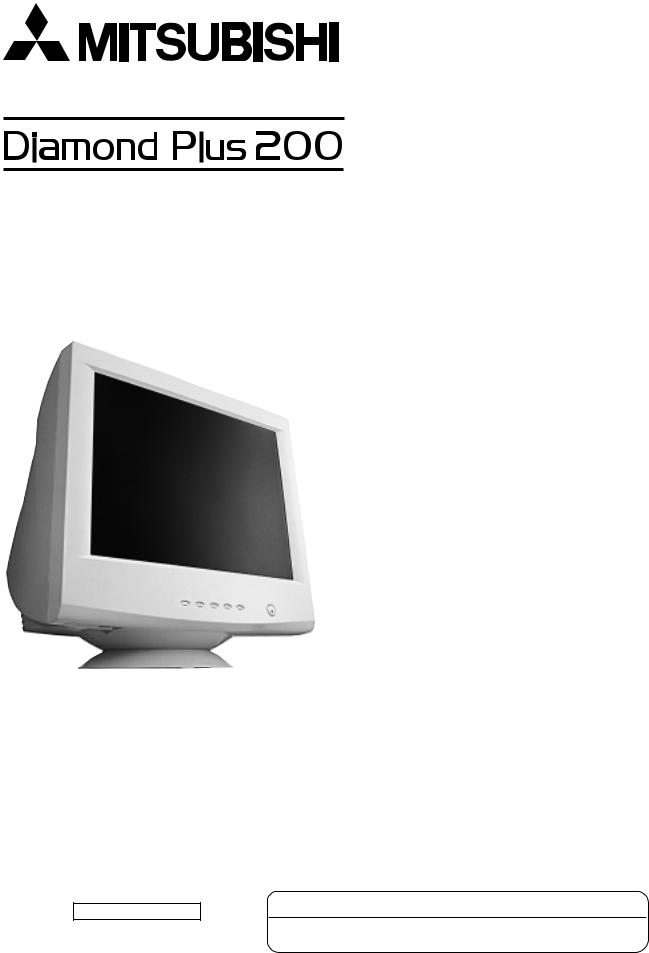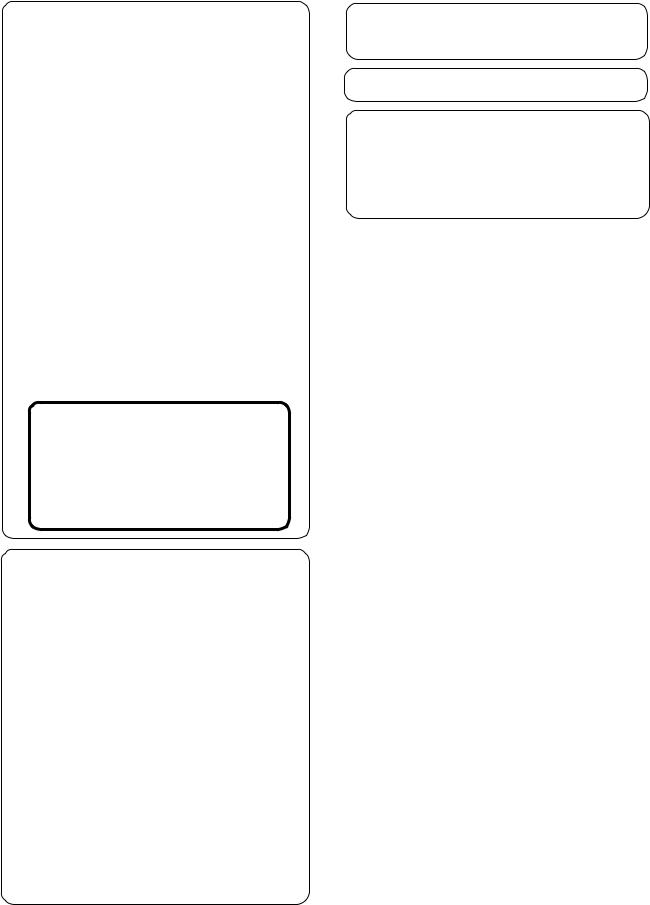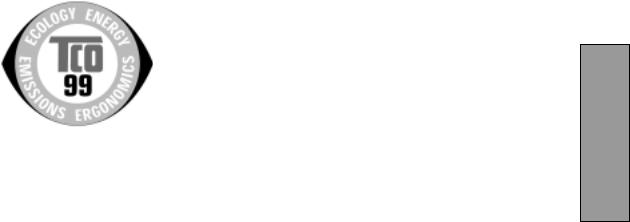Mitsubishi DIAMOND PLUS 200 User Manual

AUTO-SCANNING WITH DIGITAL CONTROL COLOR DISPLAY MONITOR
MODEL NSH1117STTKW
USER’S GUIDE
For future reference, record the serial number of your display monitor in the space below:
SERIAL No.
The serial number is located on the rear cover of the monitor.
Internet Home Page: http://www.mitsubishi-display.com/
Supplying Windows® 95/98 INF File download service, new product information, etc.
- 2 -

CAUTION
The power cord provided with this monitor is designed for safety and must be used with a properly grounded outlet to avoid possible electrical shock.
Do not remove the monitor cabinet as this can expose you to very high voltages and other hazards.
MANUFACTURER DECLARATION FOR CE-MARK- ING:
We, Mitsubishi Electric Corp., declare under our sole responsibility, that this product is in conformity with the following standards:
EN60950 EN55022 Class B EN50082-1 EN61000-3-2 EN61000-3-3
following the provisions of:
73/23/EEC Low Voltage Directive 89/336/EEC EMC Directive
WARNING!
This product is not designed for use in life support devices and Mitsubishi Electric corporation makes no representations to the contrary. Life support devices are those devices which are used to measure, diagnose, or evaluate the tissue, systems or functions of the human body; or other devices employed to support or sustain life or good health.
Trademark
IBM, PC, PS/2, PS/V, Personal System/2 are registered trademarks of International Business Machines Corp.
Apple Macintosh is a registered trademark of Apple Computer, Inc.
Quadra is a trademark of Apple Computer, Inc.
UNIX is a registered trademark in the United States and other countries, licensed exclusively through X/Open Company Limited.
ENERGY STAR is a U.S. registered mark.
© 1999 MITSUBISHI ELECTRIC CORPORATION
CONTENTS
1. |
INTRODUCTION ..................................................... |
6 |
|
|
1.1 |
Features ........................................................ |
6 |
|
1.2 |
Internal Preset Memory Capability ................ |
7 |
|
1.3 |
Power Management Function ....................... |
7 |
|
1.4 DDC .............................................................. |
7 |
|
|
1.5 |
Location Considerations ............................... |
7 |
|
1.6 |
Cleaning Your Monitor .................................. |
7 |
|
1.7 |
Unpacking ..................................................... |
8 |
|
1.8 |
Tilt/Swivel Base ............................................. |
8 |
|
|
Screen Position Adjustment .......................... |
8 |
|
1.9 |
Quick Operation Chart .................................. |
8 |
2. |
PART NAME ............................................................ |
9 |
|
|
2.1 |
Control Names .............................................. |
9 |
|
2.2 |
Function ........................................................ |
9 |
3. |
INSTALLATION AND CONNECTION ..................... |
10 |
|
|
3.1 |
AC Power Connection ................................... |
10 |
|
3.2 |
Signal Cable Connection .............................. |
10 |
|
3.2.1 Connecting to any IBM VGA Compatible |
|
|
|
|
System ................................................... |
10 |
|
3.2.2 Connecting to an Apple Macintosh |
|
|
|
|
Computer ............................................... |
10 |
|
3.2.3 Connecting to two computers ................ |
10 |
|
|
3.3 |
Installation of USB Function .......................... |
11 |
4. |
OSD(On Screen Display) FUNCTIONS .................. |
13 |
|
|
4.1 |
How to adjust the screen .............................. |
13 |
|
4.2 |
Adjustment Items .......................................... |
14 |
5. |
TROUBLESHOOTING ............................................ |
17 |
|
6. |
SPECIFICATIONS ................................................... |
19 |
|
7. |
APPENDIX .............................................................. |
20 |
|
|
7.1 |
Monitor Signal Input Connector (DB9-15P) .. |
20 |
|
7.2 |
SC-B104 Signal Cable .................................. |
20 |
|
7.3 |
Optional Macintosh Adapter AD-A205 Settings |
20 |
ENGLISH
- 3 -

RADIO INTERFERENCE REGULATIONS STATEMENT FOR U.S.A.
This equipment has been tested and found to comply with the limits for a Class B digital device, pursuant to Part 15 of the FCC Rules. These limits are designed to provide reasonable protection against harmful interference in a residential installation. This equipment generates, uses and can radiate radio frequency energy and, if not installed and used in accordance with the instructions, may cause harmful interference to radio communications. However, there is no guarantee that interference will not occur in a particular installation. If this equipment does cause harmful interference to radio or television reception, which can be determined by turning the equipment off and on, the user is encouraged to try to correct the interference by one or more of the following measures:
-Reorient or relocate the receiving antenna.
-Increase the separation between the equipment and receiver.
-Connect the equipment into an outlet on a circuit different from that to which the receiver is connected.
-Consult the dealer or an experienced radio/TV technician for help.
THIS PRODUCT HAS BEEN TESTED AND FOUND
TO COMPLY WITH THE LIMITS WITH SIGNAL CABLE SC-B104. USE IT TO REDUCE THE POSSIBILITY OF CAUSING INTERFERENCE TO RADIO,
TELEVISION, AND OTHER ELECTRIC DEVICES. NO USER SERVICEABLE PARTS INSIDE. DO
NOT ATTEMPT TO MODIFY THIS EQUIPMENT. IF MODIFIED, YOUR AUTHORITY TO OPERATE THIS EQUIPMENT MIGHT BE VOIDED BY FCC.
Declaration of Conformity - United States only
Product Name: 22 in. (55cm) Color Display Monitor Type: NSH1117STTKW
Brand Name: MITSUBISHI
This device complies with Part 15 of the FCC Rules. Operation is subject to the following two conditions: (1) this device may not cause harmful interference, and (2) this device must accept any interference received, including interference that may cause undesired operation.
For questions regarding this declaration, contact: Mitsubishi Electronics America, Inc. 5665 Plaza Drive, P.O. Box 6007, Cypress, California 90630-0007
or, call
714-220-2500
To identify this product, refer to the model number found on the product.
As an ENERGY STAR Partner, Mitsubishi Electric Corporation has determined that this product meets the ENERGY STAR guidelines for energy efficiency.
(VCCI) B
- 4 -

Congratulations!
You have just purchased a TCO’99 approved and labelled product! Your choice has provided you with a product developed for professional use. Your purchase has also contributed to reducing the burden on the environment and also to the further development of environmentally adapted electronics products.
Why do we have environmentally labelled computers?
In many countries, environmental labelling has become an established method for encouraging the adaptation of goods and services to the environment. The main problem, as far as computers and other electronics equipment are concerned, is that environmentally harmful substances are used both in the products and during their manufacture. Since it is not so far possible to satisfactorily recycle the majority of electronics equipment, most of these potentially damaging substances sooner or later enter nature.
There are also other characteristics of a computer, such as energy consumption levels, that are important from the viewpoints of both the work (internal) and natural (external) environments. Since all methods of electricity generation have a negative effect on the environment (e.g. acidic and climate-influencing emissions, radioactive waste), it is vital to save energy. Electronics equipment in offices is often left running continuously and thereby consumes a lot of energy.
What does labelling involve?
This product meets the requirements for the TCO’99 scheme which provides for international and environmental labelling of personal computers. The labelling scheme was developed as a joint effort by the TCO (The Swedish Confederation of Professional Employees), Svenska Naturskyddsforeningen (The Swedish Society for Nature Conservation) and Statens Energimyndighet (The Swedish National Energy Administration).
Approval requirements cover a wide range of issues: environment, ergonomics, usability, emission of electric and magnetic fields, energy consumption and electrical and fire safety.
The environmental demands impose restrictions on the presence and use of heavy metals, brominated and chlorinated flame retardants, CFCs (freons) and chlorinated solvents, among other things. The product must be prepared for recycling and the manufacturer is obliged to have an environmental policy which must be adhered to in each country where the company implements its operational policy.
The energy requirements include a demand that the computer and/or display, after a certain period of inactivity, shall reduce its power consumption to a lower level in one or more stages. The length of time to reactivate the computer shall be reasonable for the user.
Labelled products must meet strict environmental demands, for example, in respect of the reduction of electric and magnetic fields, physical and visual ergonomics and good usability.
Below you will find a brief summary of the environmental requirements met by this product. The complete environmental criteria document may be ordered from:
TCO Development
SE-114 94 Stockholm, Sweden Fax: +46 8 782 92 07
Email (Internet): development@tco.se
Current information regarding TCO’99 approved and labelled products may also be
obtained via the Internet, using the address: http://www.tco-info.com/
Environmental requirements
Flame retardants
Flame retardants are present in printed circuit boards, cables, wires, casings and housings. Their purpose is to prevent, or at least to delay the spread of fire. Up to 30% of the plastic in a computer casing can consist of flame retardant substances. Most flame retardants contain bromine or chloride, and those flame retardants are chemically related to another group of environmental toxins, PCBs. Both the flame retardants containing bromine or chloride and the PCBs are suspected of giving rise to severe health effects, including reproductive damage in fish-eating birds and mammals, due to the bio-accumulative* processes. Flame retardants have been found in human blood and researchers fear that disturbances in foetus development may occur.
The relevant TCO’99 demand requires that plastic components weighing more than 25 grams must not contain flame retardants with organically bound bromine or chlorine. Flame retardants are allowed in the printed circuit boards since no substitutes are available.
Cadmium* *
Cadmium is present in rechargeable batteries and in the colour-generating layers of certain computer displays. Cadmium damages the nervous system and is toxic in high doses. The relevant TCO’99 requirement states that batteries, the colour-generating layers of display screens and the electrical or electronics components must not contain any cadmium.
Mercury* *
Mercury is sometimes found in batteries, relays and switches. It damages the nervous system and is toxic in high doses. The relevant TCO’99 requirement states that batteries may not contain any mercury. It also demands that mercury is not present in any of the electrical or electronics components associated with the labelled unit.
CFCs (freons)
The relevant TCO’99 requirement states that neither CFCs nor HCFCs may be used during the manufacture and assembly of the product. CFCs (freons) are sometimes used for washing printed circuit boards. CFCs break down ozone and thereby damage the ozone layer in the stratosphere, causing increased reception on earth of ultraviolet light with e.g. increased risks of skin cancer (malignant melanoma) as a consequence.
Lead* *
Lead can be found in picture tubes, display screens, solders and capacitors. Lead damages the nervous system and in higher doses, causes lead poisoning. The relevant TCO´99 requirement permits the inclusion of lead since no replacement has yet been developed.
*Bio-accumulative is defined as substances which accumulate within living organisms
**Lead, Cadmium and Mercury are heavy metals which are Bio-accumulative.
ENGLISH
- 5 -

1 INTRODUCTION
Congratulations on your purchase of the high resolution color monitor. We designed this monitor to provide you with years of reliable trouble-free operation.
This guide tells you how to connect, adjust and care for your monitor. This guide also provides technical specifications and instructions for troubleshooting any basic problems you may experience with your monitor.
1.1Features
This monitor is a 55cm/22"(51cm/20" Diagonal Viewable Image) intelligent, microprocessor-based monitor compatible with most analog RGB (Red, Green, Blue) display standards.
It provides crisp text and vivid color graphics with both PC and Macintosh platforms.
•The monitor’s wide auto-scanning compatibility range makes it possible to upgrade video cards or software without purchasing a new monitor.
•Digitally controlled auto-scanning is done using an internal microprocessor, for horizontal scan frequencies between 30kHz and 108kHz, and vertical scan frequencies between 50Hz and 160Hz. The micropro- cessor-based intelligence allows the monitor to operate in each frequency mode with the precision of a fixed frequency monitor.
•The monitor contains resident memory for pre-pro- grammed screen display standards and is also capable of storing additional user adjustment parameters.
•The monitor is capable of producing a non-interlaced maximum addressable resolution format of 1800 dots x 1440 lines. This display is well suited for windowing environments.
•Because of the analog signal inputs, the monitor can display an unlimited palette of colors that can be manually adjusted to suit your specific needs.
•The monitor has a power management function accorded to VESATM-DPMSTM-standard. To save energy,
the monitor must be connected to a system compliant with the VESATM -DPMSTM-standard. (Refer to your computer and/or video card instructions for proper operation.)
•To ensure ease of installation and ongoing use, the monitor features On Screen Display (OSD) of all monitor set-up and adjustment functions.
•For use in a variety of applications, the monitor complies with UL 1950, CSA C22.2 No.950 and EN60950 for safety, FCC Class-B, VCCI Class-B and EN55022 Class-B for EMI, MPR-II, ISO 9241-3, ISO9241-7 and ISO9241-8 for ergonomics. The monitor also complies with TCO’99 guideline for environmental safe use.
•The world's standard DIAMONDTRON NF CRT upgraded and pure picture images.
•The monitor complies with Video Electronics Standards Association (VESATM) DDCTM1/2B(EDID) specification. If your computer is Plug & Play compliant setup will be done automatically.
•Fine 0.24mm aparture grille pitch/Maximum addressable resolution of 1800 x 1440.
- 6 -

1.2Internal Preset Memory Capability
To minimize adjustment needs, the factory has preset popular display standards into the monitor, as shown in Table 1. If any of these display standards are detected, the picture size and position are automatically adjusted. All of the factory presets may be overwritten by adjusting the user controls. This monitor is capable of automatically storing up to 15 additional display standards. The new display information must differ from any of the existing display standards by at least 1kHz for the horizontal scan frequency or 1Hz for the vertical scan frequency or the sync signal polarities must be different.
Table 1. Memory Buffer Factory Presets
|
PRESET |
|
|
|
Polarity |
||
|
TIMING |
|
Fh(kHz) |
Fv (Hz) |
H |
V |
|
|
|
|
|
|
|
|
|
640 |
x |
480 |
N.I. |
31.5 |
60.0 |
– |
– |
800 |
x |
600 |
N.I. |
53.7 |
85.1 |
+ |
+ |
1024 |
x |
768 |
N.I. |
60.0 |
75.0 |
+ |
+ |
1024 |
x |
768 |
N.I. |
68.7 |
85.0 |
+ |
+ |
1152 |
x |
870 |
N.I. |
68.7 |
75.1 |
– |
– |
1280 |
x |
1024 |
N.I. |
80.0 |
75.0 |
+ |
+ |
1280 |
x |
1024 |
N.I. |
91.1 |
85.0 |
+ |
+ |
1600 |
x |
1200 |
N.I. |
93.8 |
75.0 |
+ |
+ |
1600 |
x |
1200 |
N.I. |
106.3 |
85.0 |
+ |
+ |
1.3Power Management Function
The monitor has a power management function which reduces the power consumption of the monitor when not in use.
Power saving mode is invoked by a VESA DPMScompliant computer. Check your computer's manual for setting this function.
Mode |
Power |
Power-On Indicator |
Normal |
140 W |
Green |
|
|
|
Power Saving Mode |
5 W |
Amber |
|
|
|
1.4DDC
The monitor includes the VESA DDCTM1 and DDCTM2B feature. DDC (Display Data Channel) is a communication channel over which the monitor automatically informs the computer system about its capabilities (e.g. each supported resolution with its corresponding timing).
DDC is routed through previously unused pins of the 15-pin VGA connector.
The system will “Plug and Play” if both monitor and computer implement the DDC protocol.
1.5Location Considerations
When setting up and using the monitor, keep the following in mind:
• |
For optimum viewing, avoid placing the monitor |
ENGLISH |
|
||
|
against a bright background or where sunlight or |
|
|
other light sources may reflect on the display area of |
|
|
the monitor. Place the monitor just below eye level. |
|
• |
Place the monitor away from strong magnetic or |
|
|
electromagnetic fields, such as high capacity trans- |
|
|
formers, electric motors, large current power lines, |
|
|
steel pillars, etc.... |
|
|
Magnetism can cause distortion in the picture and/or |
|
• |
color purity. |
|
|
||
Avoid covering the slots or openings of the monitor. |
|
|
|
Allow adequate ventilation around the monitor so the |
|
|
heat from the monitor can properly dissipate. Avoid |
|
|
putting the monitor into any enclosure that does not |
|
|
have adequate ventilation. |
|
• |
Avoid exposing the monitor to rain, excessive mois- |
|
|
ture, or dust, as this can cause a fire or shock hazard. |
|
• |
Avoid placing the monitor, or any other heavy object, |
|
|
on the power cord. Damage to the power cord can |
|
|
cause a fire or electrical shock. |
|
• |
When transporting the monitor, handle it with care. |
|
1.6Cleaning Your Monitor
When cleaning the monitor, please follow these guidelines:
•Always unplug the monitor before cleaning.
•Wipe the screen and cabinet front and sides with a soft unspoil cloth to prevent causing imperfections.
•If the screen requires more than dusting, apply water or neutral detergent to a soft cloth to clean the monitor screen.
CAUTION
•Do not use benzene, thinner or any volatile substances to clean the unit as the finish may be permanently marked.
•Never leave the monitor in contact with rubber or vinyl for an extended time period.
•Do not spray directly on the screen as cleaner may drip into the monitor and damage the circuitry.
•Never use an abrasive cleaner on the screen surface as this will damage the anti-reflection coating.
- 7 -
